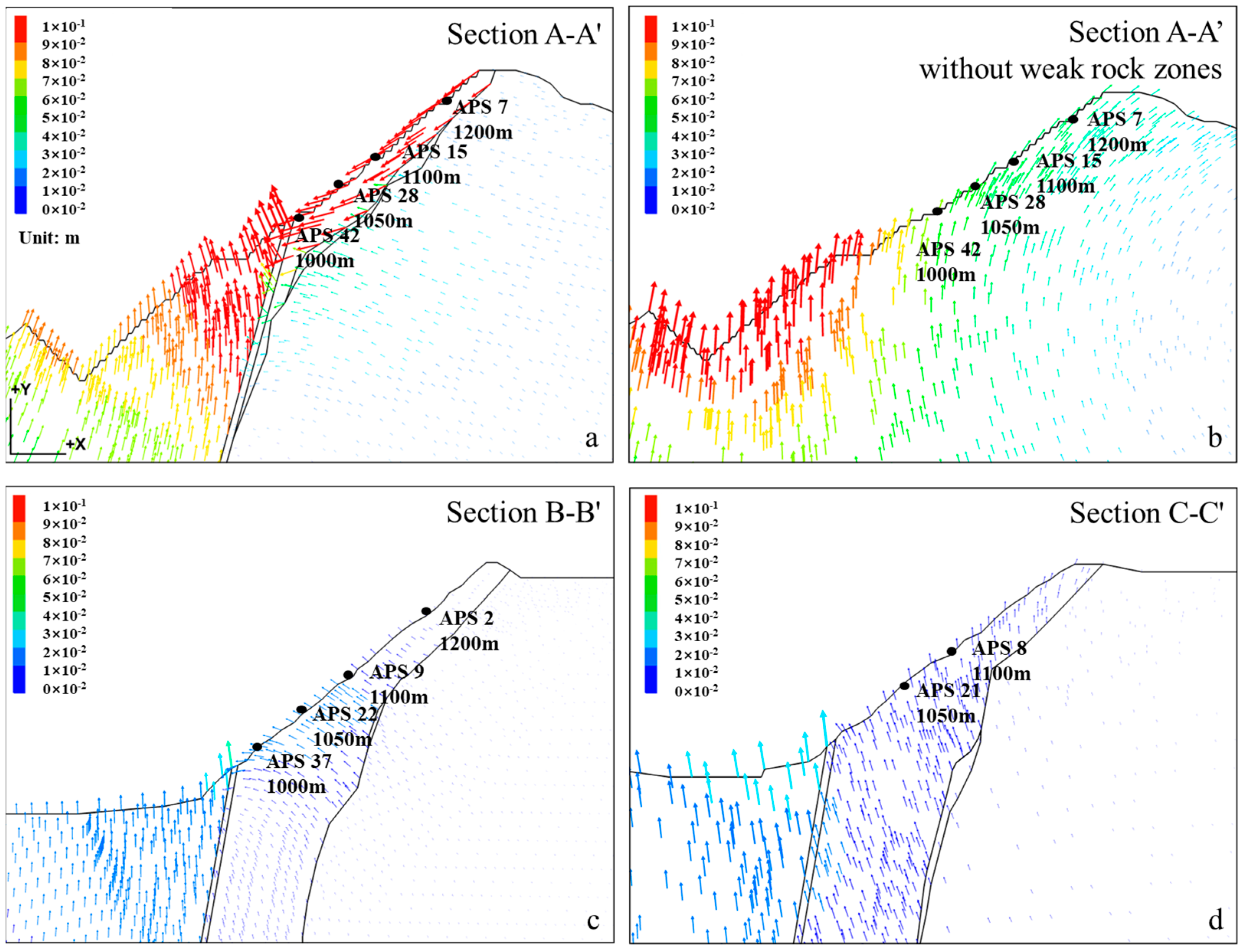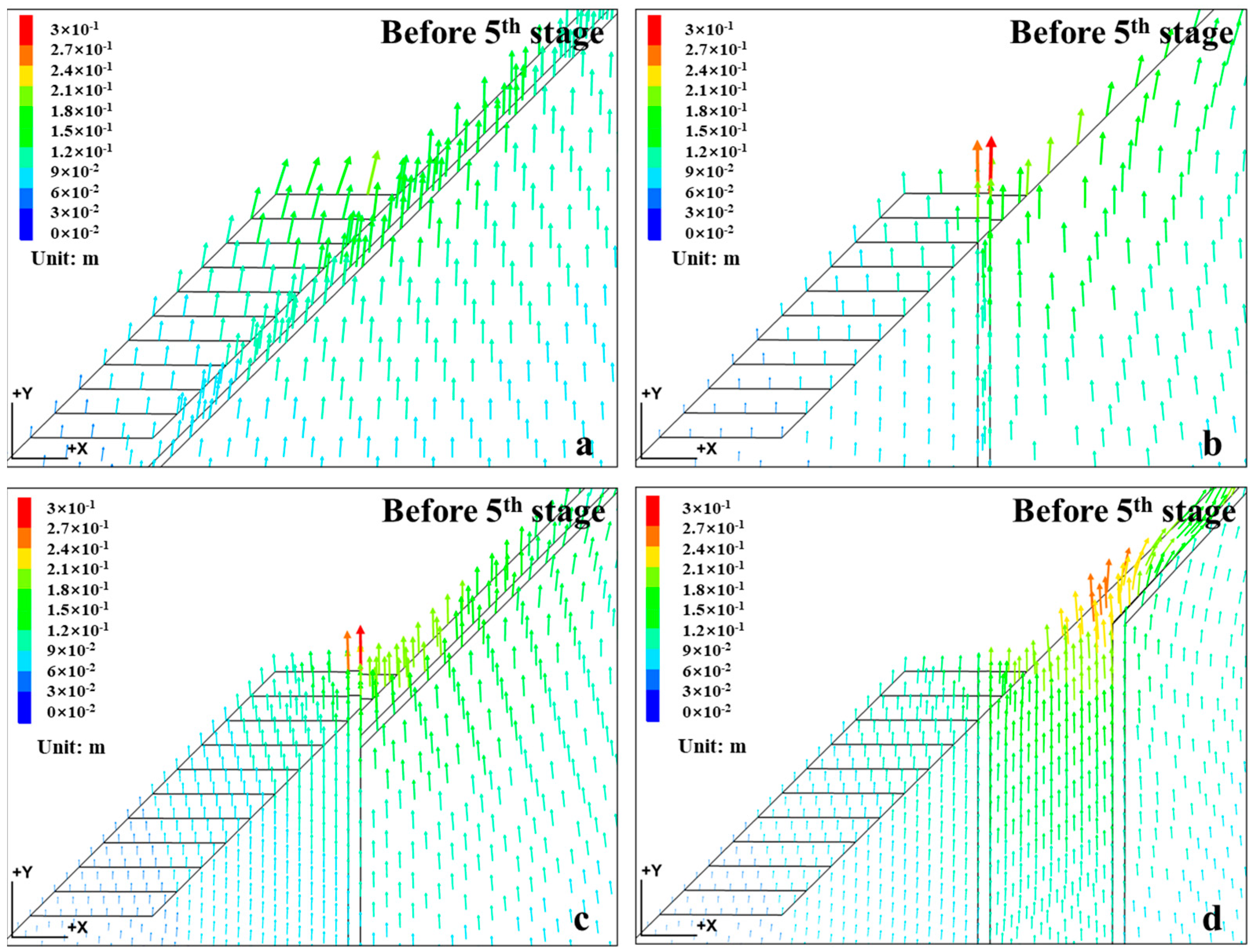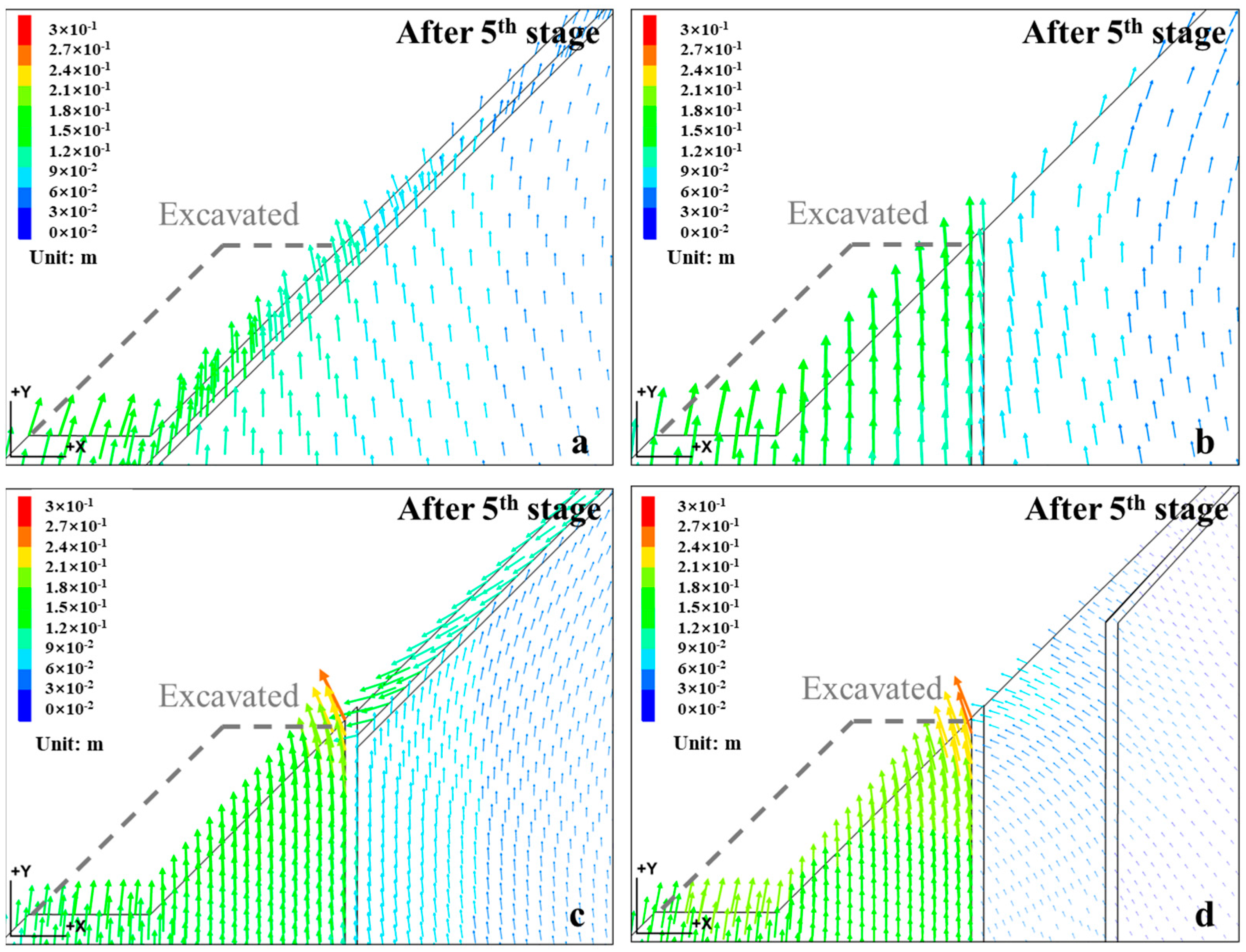Effect of the Connectivity of Weak Rock Zones on the Mining-Induced Deformation of Rock Slopes in an Open-Pit Mine
Abstract
:1. Introduction
2. Geological Conditions and Rock Slope Deformation of the Case Study Quarry
2.1. Geological Conditions Including Weak Rock Zones
2.2. Measurement of the Rock Slope Displacement Using the Automated Polar System (APS)
3. Numerical Modeling for Simulation of the Rock Slope Deformation of the Quarry
3.1. Estimation of Mechanical Properties of the Rock Mass
3.2. Numerical Models and Simulation Procedure
3.3. Calculation of the Change in Distance
4. Simulation Results
4.1. Change in Distance and Displacement Vector
4.2. Impacts of Young’s Modulus of the Vertical Weak Rock Zone
5. Discussion
5.1. Effect of the Connectivity of Weak Rock Zones on Mining-Induced Deformations
5.1.1. Model Introduction
5.1.2. Simulation Procedure and Monitoring Points
5.1.3. Simulation Results
5.1.4. Mechanism of the Sliding Movement
5.2. Interpretation of the Rock Slope Deformations Observed in the Case Study Quarry
5.2.1. Deformation Mechanism of Eastern and Western Sections
5.2.2. Reasons for the Difference in Measurements and Simulation Results
6. Conclusions
- In the west section of the quarry, the weak rock zone parallel to the slope surface, developed between the limestone and green rock, connects with the vertical weak rock zone, leading to significant displacement that eventually converges as excavation progresses. In contrast, the east section has less developed parallel weak rock zones with little observed displacement.
- The displacement observed in the west section can be qualitatively explained by numerical simulation, assuming the geological boundaries as discontinuous. Mining-induced stress changes cause shear failure at these boundaries. As the excavation face passes the vertical weak rock zone, the bending stiffness at the foot of the rock slope decreases, leading to sliding deformation along the parallel weak rock zone. However, the resistance force against bending deformation increases as mining progresses, eventually stopping the sliding deformation when resistance equals sliding force.
Author Contributions
Funding
Institutional Review Board Statement
Informed Consent Statement
Data Availability Statement
Acknowledgments
Conflicts of Interest
References
- Rose, N.D.; Hungr, O. Forecasting potential rock slope failure in open pit mines using the inverse-velocity method. Int. J. Rock Mech. Min. Sci. 2007, 44, 308–320. [Google Scholar] [CrossRef]
- Assefa, S.; Graziani, A.; Lembo-Fazio, A. A slope movement in a complex rock formation: Deformation measurements and DEM modelling. Eng. Geol. 2017, 219, 74–91. [Google Scholar] [CrossRef]
- López-Vinielles, J.; Ezquerro, P.; Fernández-Merodo, J.A.; Béjar-Pizarro, M.; Monserrat, O.; Barra, A.; Blanco, P.; García-Robles, J.; Filatov, A.; García-Davalillo, J.C.; et al. Remote analysis of an open-pit slope failure: Las Cruces case study, Spain. Landslides 2020, 17, 2173–2188. [Google Scholar] [CrossRef]
- An, B.; Wang, C.; Liu, C.; Li, P. A multi-source remote sensing satellite view of the February 22nd Xinjing landslide in the mining area of Alxa left Banner, China. Landslides 2023, 20, 2517–2523. [Google Scholar] [CrossRef]
- Kaneko, K.; Noguchi, Y.; Soda, K.; Hazuku, M. Stability Assesment of Rock Slope by Displacement Measurement. J. Mmij 1996, 112, 915–920. [Google Scholar] [CrossRef]
- Obara, Y.; Nakamura, N.; Kang, S.S.; Kaneko, K. Measurement of local stress and estimation of regional stress associated with stability assessment of an open-pit rock slope. Int. J. Rock Mech. Min. Sci. 2000, 37, 1211–1221. [Google Scholar] [CrossRef]
- Kodama, J.; Nishiyama, E.; Kaneko, K. Measurement and interpretation of long-term deformation of a rock slope at the Ikura limestone quarry, Japan. Int. J. Rock Mech. Min. Sci. 2009, 46, 148–158. [Google Scholar] [CrossRef]
- Kodama, J.; Miyamoto, T.; Kawasaki, S.; Fujii, Y.; Kaneko, K.; Hagan, P. Estimation of regional stress state and Young’s modulus by back analysis of mining-induced deformation. Int. J. Rock Mech. Min. Sci. 2013, 63, 1–11. [Google Scholar] [CrossRef]
- Najib; Fukuda, D.; Kodama, J.-I.; Fujii, Y. The Deformation Modes of Rock Slopes due to Excavation in Mountain-Type Mines. Mater. Trans. 2015, 56, 1159–1168. [Google Scholar] [CrossRef]
- Amagu, C.A.; Zhang, C.; Kodama, J.-I.; Shioya, K.; Yamaguchi, T.; Sainoki, A.; Fukuda, D.; Fujii, Y.; Sharifzadeh, M. Displacement Measurements and Numerical Analysis of Long-Term Rock Slope Deformation at Higashi-Shikagoe Limestone Quarry, Japan. Adv. Civ. Eng. 2021, 2021, 1316402. [Google Scholar] [CrossRef]
- Abdellah, W.R.; Hirohama, C.; Sainoki, A.; Towfeek, A.R.; Ali, M.A.M. Estimating the Optimal Overall Slope Angle of Open-Pit Mines with Probabilistic Analysis. Appl. Sci. 2022, 12, 4746. [Google Scholar] [CrossRef]
- Sdvyzhkova, O.; Moldabayev, S.; Bascetin, A.; Babets, D.; Kuldeyev, E.; Sultanbekova, Z.; Amankulov, M.; Issakov, B. Probabilistic assessment of slope stability at ore mining with steep layers in deep open pits. Min. Miner. Depos. 2022, 16, 11–18. [Google Scholar] [CrossRef]
- Hocking, G. A method for distinguishing between single and double plane sliding of tetrahedral wedges. Int. J. Rock Mech. Min. Sci. 1976, 13, 225–226. [Google Scholar] [CrossRef]
- Hoek, E.; Bray, J.D. Rock Slope Engineering; CRC Press: Boca Raton, FL, USA, 1981. [Google Scholar]
- Yoon, W.; Jeong, U.; Kim, J. Kinematic analysis for sliding failure of multi-faced rock slopes. Eng. Geol. 2002, 67, 51–61. [Google Scholar] [CrossRef]
- Lee, C.-Y.; Wang, I.-T. Analysis of highway slope failure by an application of the stereographic projection. Int. J. Geol. Environ. Eng. 2011, 5, 122–129. [Google Scholar]
- Tang, H.; Yong, R.; Ez Eldin, M. Stability analysis of stratified rock slopes with spatially variable strength parameters: The case of Qianjiangping landslide. B Eng. Geol. Env. 2017, 76, 839–853. [Google Scholar] [CrossRef]
- Glastonbury, J.; Fell, R. Report on the Analysis of “Rapid” Natural Rock Slope Failures; School of Civil and Environmental Engineering, University of New South Wales: Sydney, Australia, 2000. [Google Scholar]
- MacLaughlin, M.; Sitar, N.; Doolin, D.; Abbot, T. Investigation of slope-stability kinematics using discontinuous deformation analysis. Int. J. Rock Mech. Min. Sci. 2001, 38, 753–762. [Google Scholar] [CrossRef]
- Stead, D.; Wolter, A. A critical review of rock slope failure mechanisms: The importance of structural geology. J. Struct. Geol. 2015, 74, 1–23. [Google Scholar] [CrossRef]
- Azarfar, B.; Ahmadvand, S.; Sattarvand, J.; Abbasi, B. Stability Analysis of Rock Structure in Large Slopes and Open-Pit Mine: Numerical and Experimental Fault Modeling. Rock Mech. Rock Eng. 2019, 52, 4889–4905. [Google Scholar] [CrossRef]
- Kaczmarek, Ł.D.; Popielski, P. Selected components of geological structures and numerical modelling of slope stability. Open Geosci. 2019, 11, 208–218. [Google Scholar] [CrossRef]
- Li, Y.; Yu, L.; Song, W.; Yang, T. Three-Dimensional Analysis of Complex Rock Slope Stability Affected by Fault and Weak Layer Based on FESRM. Adv. Civ. Eng. 2019, 2019, 6380815. [Google Scholar] [CrossRef]
- Wang, L.-Y.; Chen, W.-Z.; Tan, X.-Y.; Tan, X.-J.; Yuan, J.-Q.; Liu, Q. Evaluation of mountain slope stability considering the impact of geological interfaces using discrete fractures model. J. Mt. Sci. 2019, 16, 2184–2202. [Google Scholar] [CrossRef]
- Lemaire, E.; Mreyen, A.-S.; Dufresne, A.; Havenith, H.-B. Analysis of the Influence of Structural Geology on the Massive Seismic Slope Failure Potential Supported by Numerical Modelling. Geosciences 2020, 10, 323. [Google Scholar] [CrossRef]
- Vick, L.M.; Böhme, M.; Rouyet, L.; Bergh, S.G.; Corner, G.D.; Lauknes, T.R. Structurally controlled rock slope deformation in northern Norway. Landslides 2020, 17, 1745–1776. [Google Scholar] [CrossRef]
- Xie, J.; Yang, G.L.; Qin, Y.G.; Xu, X.T. Deformation Failure Mechanism and Motion Laws of Near-horizontal Thick-layer with Thin-layer Columnar Dangerous Rock Mass in the Chishui Red Bed Area. IOP Conf. Ser. Earth Environ. Sci. 2020, 570, 022045. [Google Scholar] [CrossRef]
- Zerradi, Y.; Souissi, M.; Larabi, A. Application of the deterministic block theory to the slope stability design of an open-pit mine in Morocco. Min. Miner. Depos. 2023, 17, 53–60. [Google Scholar] [CrossRef]
- Nie, L.; Li, Z.C.; Zhang, M.; Xu, L.N. Deformation characteristics and mechanism of the landslide in West Open-Pit Mine, Fushun, China. Arab. J. Geosci. 2015, 8, 4457–4468. [Google Scholar] [CrossRef]
- Amini, M.; Ardestani, A. Stability analysis of the north-eastern slope of Daralou copper open pit mine against a secondary toppling failure. Eng. Geol. 2019, 249, 89–101. [Google Scholar] [CrossRef]
- Eang, K.E.; Igarashi, T.; Kondo, M.; Nakatani, T.; Tabelin, C.B.; Fujinaga, R. Groundwater monitoring of an open-pit limestone quarry: Water-rock interaction and mixing estimation within the rock layers by geochemical and statistical analyses. Int. J. Min. Sci. Technol. 2018, 28, 849–857. [Google Scholar] [CrossRef]
- Yamatomi, J.; Sugiyama, T.; Mikami, K.; Wakisaka, T.; Yamaguchi, U. Limestone Mining and Slope Management at Mt. Buko. J. MMIJ 2018, 134, 161–169. [Google Scholar] [CrossRef]
- Nakatani, T.; Fujimaki, K.; Hirasawa, Y.; Akiyama, F.; Miyayumi, T.; Tanaka, K. Monitoring of the Surface Displacements of the Final Slope at Mt.Buko. J. MMIJ 2018, 134, 170–178. [Google Scholar] [CrossRef]
- Ozawa, N. Analyzing the Impacts of Rainfall on Rock Slope Behavior in Une Mine and Evaluating the Effec-Tiveness of Countermeasure Methods. J. MMIJ 2018, 134, 208–221. [Google Scholar] [CrossRef]
- Yamaguchi, U. Cooperative Mining of Limestone at Mt. Buko and the Task Group for Research on Rock Slope in Chichibu Area (Chichibu Zanken). J. MMIJ 2018, 134, 67–73. [Google Scholar] [CrossRef]
- Itasca. UDEC, Version 7.0; Theory and Background; Itasca Consulting Group Inc.: Minneapolis, MN, USA, 2021.
- Marinos, P.; Hoek, E. Gsi: A Geologically Friendly Tool for Rock Mass Strength Estimation. In Proceedings of the ISRM International Symposium, Melbourne, Australia, 19–24 November 2000; p. ISRM-IS-2000-2035. [Google Scholar]
- Aboutaleb, S.; Bagherpour, R.; Behnia, M.; Aghababaei, M. Combination of the Physical and Ultrasonic Tests in Estimating the Uniaxial Compressive Strength and Young’s Modulus of Intact Limestone Rocks. Geotech. Geol. Eng. 2017, 35, 3015–3023. [Google Scholar] [CrossRef]
- ASTM D2938-95; Standard Test Method for Unconfined Compressive Strength of Intact Rock Core Specimens. ASTM International: West Conshohocken, PA, USA, 2022.
- Majdi, A.; Bashari, A.; Beiki, M. Estimation of Rock Mass Deformation Modulus Based on GSI System. In Proceedings of the 12th ISRM Congress, Beijing, China, 8–21 October 2011. [Google Scholar]
- Day, J.J.; Diederichs, M.S.; Hutchinson, D.J. New direct shear testing protocols and analyses for fractures and healed intrablock rockmass discontinuities. Eng. Geol. 2017, 229, 53–72. [Google Scholar] [CrossRef]
- Bandis, S.C.; Lumsden, A.C.; Barton, N.R. Fundamentals of rock joint deformation. Int. J. Rock Mech. Min. Sci. Geomech. Abstr. 1983, 20, 249–268. [Google Scholar] [CrossRef]
- Gu, R.; Ozbay, U. Distinct element analysis of unstable shear failure of rock discontinuities in underground mining conditions. Int. J. Rock Mech. Min. Sci. 2014, 68, 44–54. [Google Scholar] [CrossRef]
- Zhu, J.B.; Deng, X.F.; Zhao, X.B.; Zhao, J. A Numerical Study on Wave Transmission Across Multiple Intersecting Joint Sets in Rock Masses with UDEC. Rock Mech. Rock Eng. 2013, 46, 1429–1442. [Google Scholar] [CrossRef]
- Peacock, D.C.P.; Xing, Z. Field examples and numerical modelling of oversteps and bends along normal faults in cross-section. Tectonophysics 1994, 234, 147–167. [Google Scholar] [CrossRef]
- Jiang, Y.; Yamashita, Y.; Sawada, M.; Li, B.; Etou, Y. Evaluation of Progressive Failure Mechanism in Jointed Rock Slopes by applying Extended Distinct Element Method. J. MMIJ 2008, 124, 771–776. [Google Scholar] [CrossRef]
- Kuraoka, S.; Monma, K.; Shuzui, H. Numerical Analysis of Jointed Rock Slope in Practice. J. Jpn. Soc. Eng. Geol. 2000, 41, 24–33. [Google Scholar] [CrossRef]
- Bunyu, H.; Higashi, S.; Sainoki, A. Elucidation of Microscopic Stress State within Surface Asperities of a Rock Joint. In Proceedings of the 15th ISRM Congress, Salzburg, Austria, 9–14 October 2023; p. ISRM-15CONGRESS-2023-2405. [Google Scholar]
- Cao, J.; Wang, T.; Zhou, G.; Feng, X.; Zhu, C. Parameter estimation of grouting pressure and surface subsidence on the reliability of shield tunnel excavation under incomplete probability information. Comput. Geotech. 2024, 173, 106530. [Google Scholar] [CrossRef]
- Mondol, N.H.; Jahren, J.; Bjørlykke, K.; Brevik, I. Elastic properties of clay minerals. Lead. Edge 2008, 27, 758–770. [Google Scholar] [CrossRef]
- Rastegarnia, A.; Lashkaripour, G.R.; Sharifi Teshnizi, E.; Ghafoori, M. Evaluation of engineering characteristics and estimation of static properties of clay-bearing rocks. Environ. Earth Sci. 2021, 80, 621. [Google Scholar] [CrossRef]
- Kulhawy, F.H.; Mayne, P.W. Manual on Estimating Soil Properties for Foundation Design; Cornell University: Tompkins, NY, USA, 1990; 298p. [Google Scholar]
- Erguler, Z.A.; Ulusay, R. Water-induced variations in mechanical properties of clay-bearing rocks. Int. J. Rock Mech. Min. Sci. 2009, 46, 355–370. [Google Scholar] [CrossRef]
- Najib. Elastic Deformation of Rock Slopes Due to Excavation in Open Pit Mines. Ph.D. Thesis, Hokkaido University, Sapporo city, Japan, 2015. [Google Scholar]
- Kondo, M.; Aoyama, H.; Ozawa, N.; Yano, K. Countermeasures Against Rainfalls: Towards Stabilizing the Slope at the Une Mine. J. MMIJ 2018, 134, 198–207. [Google Scholar] [CrossRef]
- Cao, J.; Wang, T.; Sheng, M.; Huang, Y.; Mo, P.; Zhou, G. Assessment of multi-dimensional joint probability distribution for uncertain mechanical strength parameters under small sample test data. Probabilistic Eng. Mech. 2023, 74, 103511. [Google Scholar] [CrossRef]
- Pan, Y.; Wu, G.; Zhao, Z.; He, L. Analysis of rock slope stability under rainfall conditions considering the water-induced weakening of rock. Comput. Geotech. 2020, 128, 103806. [Google Scholar] [CrossRef]
- Zhang, Z.; Nemcik, J. Friction Factor of Water Flow Through Rough Rock Fractures. Rock Mech. Rock Eng. 2013, 46, 1125–1134. [Google Scholar] [CrossRef]
- Zhao, Z.; Guo, T.; Ning, Z.; Dou, Z.; Dai, F.; Yang, Q. Numerical Modeling of Stability of Fractured Reservoir Bank Slopes Subjected to Water–Rock Interactions. Rock Mech. Rock Eng. 2018, 51, 2517–2531. [Google Scholar] [CrossRef]



















| Properties | Intact Limestone | Intact Green Rock |
|---|---|---|
| Density (kg·m−3) | 2548 | 2646 |
| Young’s modulus (GPa) | 58.1 | 34.2 |
| Poisson’s ratio | 0.25 | 0.25 |
| Properties | Parallel Weak Rock Zone | Vertical Weak Rock Zone | Limestone | Green Rock |
|---|---|---|---|---|
| Density (kg·m−3) | 2597 | 2548 | 2548 | 2646 |
| Young’s modulus (GPa) | 1.3 | 1.5 | 20.4 | 15.6 |
| Poisson’s ratio | 0.25 | 0.25 | 0.25 | 0.25 |
| Rock Type | Young’s Modulus (GPa) | Kn (GPa/m) | Ks (GPa/m) | Kn/Ks | Friction (°) | Scale | Resource |
|---|---|---|---|---|---|---|---|
| Limestone | 12 | 10 | 5 | 2 | 43.9 | meter-scale | (Day et al. 2017) [41] |
| Limestone | 49 | 8.53 | 3.019 | 2.82 | - | meter-scale | (Bandis et al. 1983) [42] |
| - | 200 | 100 | 100 | 1 | 30 | meter-scale | (Gu et al. 2014) [43] |
| Granite | 93.4 | 128.62 | 50.67 | 2.53 | 26 | meter-scale | (Zhu et al. 2013) [44] |
| Limestone | 12 | 10 | 4.8 | 2.08 | 30 | meter-scale | (Peacock et al. 1994) [45] |
| Sandstone | 23 | 11.7 | 5 | 2.34 | 30 | meter-scale | (Jiang et al. 2008) [46] |
| Shale | 6 | 4.4 | 1.5 | 2.93 | 25 | meter-scale | |
| Tuff | 4.4 | 1.68 | 1.49 | 1.12 | 37 | meter-scale | (Kuraoka et al. 2000) [47] |
| Tuff | 2.9 | 0.785 | 0.637 | 1.23 | 21 | meter-scale |
| Properties | Parallel Weak Rock Zone–Rock Mass Contact | Vertical Weak Rock Zone–Rock Mass Contact |
|---|---|---|
| Kn (GPa/m) | 1.3 | 1.5 |
| Ks (GPa/m) | 0.65 | 0.75 |
| Friction angle (°) | 30 | 30 |
| Properties | Weak Rock Zone | Limestone |
|---|---|---|
| Density (kg/m3) | 2700 | 2700 |
| Young’s modulus (GPa) | 0.1 | 1 |
| Poisson’s ratio | 0.25 | 0.25 |
| Properties | Weak Rock Zone-Rock Mass Contact |
|---|---|
| Kn (GPa/m) | 0.1 |
| Ks (GPa/m) | 0.05 |
| Friction (°) | 30 |
Disclaimer/Publisher’s Note: The statements, opinions and data contained in all publications are solely those of the individual author(s) and contributor(s) and not of MDPI and/or the editor(s). MDPI and/or the editor(s) disclaim responsibility for any injury to people or property resulting from any ideas, methods, instructions or products referred to in the content. |
© 2024 by the authors. Licensee MDPI, Basel, Switzerland. This article is an open access article distributed under the terms and conditions of the Creative Commons Attribution (CC BY) license (https://creativecommons.org/licenses/by/4.0/).
Share and Cite
Zhang, C.; Clement, A.a.; Kodama, J.-i.; Sainoki, A.; Fujii, Y.; Fukuda, D.; Wang, S. Effect of the Connectivity of Weak Rock Zones on the Mining-Induced Deformation of Rock Slopes in an Open-Pit Mine. Sustainability 2024, 16, 5974. https://doi.org/10.3390/su16145974
Zhang C, Clement Aa, Kodama J-i, Sainoki A, Fujii Y, Fukuda D, Wang S. Effect of the Connectivity of Weak Rock Zones on the Mining-Induced Deformation of Rock Slopes in an Open-Pit Mine. Sustainability. 2024; 16(14):5974. https://doi.org/10.3390/su16145974
Chicago/Turabian StyleZhang, Cheng, Amagu amagu Clement, Jun-ichi Kodama, Atsushi Sainoki, Yoshiaki Fujii, Daisuke Fukuda, and Shuren Wang. 2024. "Effect of the Connectivity of Weak Rock Zones on the Mining-Induced Deformation of Rock Slopes in an Open-Pit Mine" Sustainability 16, no. 14: 5974. https://doi.org/10.3390/su16145974





